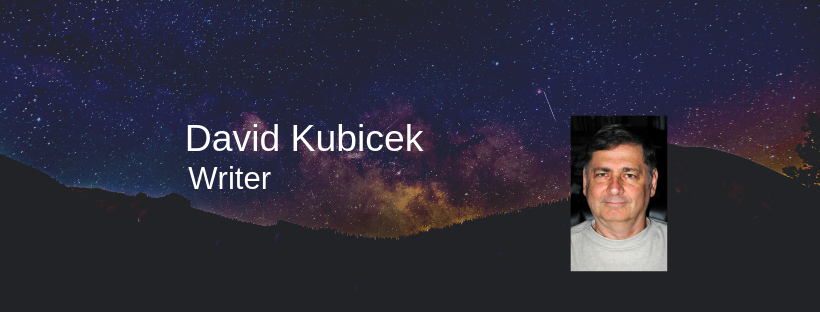by David Kubicek

Years ago I learned that planning is important, even when a goal is far in the future, even when said goal seemed like a sure thing. To my utter chagrin, I had 20 years to plan and still got caught unprepared.
To understand how this catastrophe came about we have to go back to my high school years.
During junior and senior high school , I was an amateur astronomer. Although I’d been interested in space and space objects as early as elementary school, it was the appearance of the great comet Ikeya-Seki that stoked my passing interest in astronomy into a burning passion, and this passion is what stoked my interest in science fiction. I put a space picture on my short SF collection, Prospect Street, even though none of the stories deal with space.
I went out searching for Ikeya-Seki, but because I didn’t know how comets really looked in the sky, I never managed to see it. It was supposed to be extremely bright, and it had a long tail, but it may not have been quite as noticeable as its pictures in Sky and Telescope magazine suggested.
To make a long story short, I missed the comet. But Halley’s Comet was coming in 21 years, and by that time I would know what to look for. Halley’s comet is a bright comet that has appeared reliably every 76 years dating back to ancient times (English astronomer Edmund Halley figured this out in 1682). Its appearance caused panic throughout history because people thought it portended disaster.
By 1987, when Halley’s Comet was at its brightest, I knew what a comet was supposed to look like in the sky. I was ready. Or I thought I was ready. Halley’s comet was supposed to be bright. It was supposed to be easily visible to the naked eye. Right?
Unfortunately, Halley’s Comet chose its 1986-87 return to be a dud.
Because the comet didn’t pass as close to Earth as it had on other visits, it was, I would estimate, between fifth and sixth magnitude, which is barely visible to the naked eye under optimal (very dark) conditions. Basically, the comet looked like a tiny pale white smudge against the night sky.
My brother, John, and his friend, Maureen, accompanied me to a country road way south of town (away from the city lights) for our viewing. We took my six-inch reflecting telescope, which had been stored in my parents’ attic for 15 years. Unfortunately, because the mirror had not been maintained, it had become cloudy. We saw the comet, but not as crisp and clear as we would have if the mirror had been in pristine condition.
If I’d thought this through, I would have made sure the telescope was in tip top shape before I needed it; I would have resurfaced the mirror. But I hadn’t expected to need the telescope. It was Halley’s Comet. The Halley’s Comet. The Big Honcho. The King of Comets. It should have blazed forth in all the glory of its previous visits.
To paraphrase an old saying, I should have hoped for the best, but planned for the worst.
This story has a happy ending, however. Although I was disappointed that Halley’s Comet was a dud that year, I did actually get a better view of it before it left our neighborhood of the solar system. A local astronomy group had set up some telescopes–well-maintained telescopes!–in Southeast Community College’s parking lot before dawn, and John and I went out there to take a look.
For more information about David Kubicek’s books click here.
